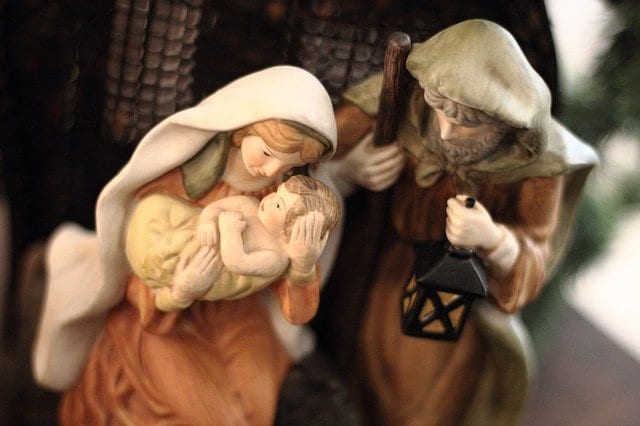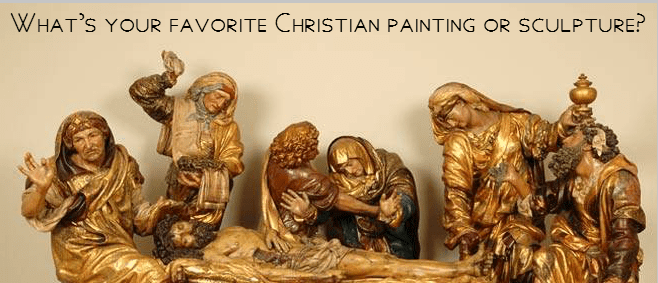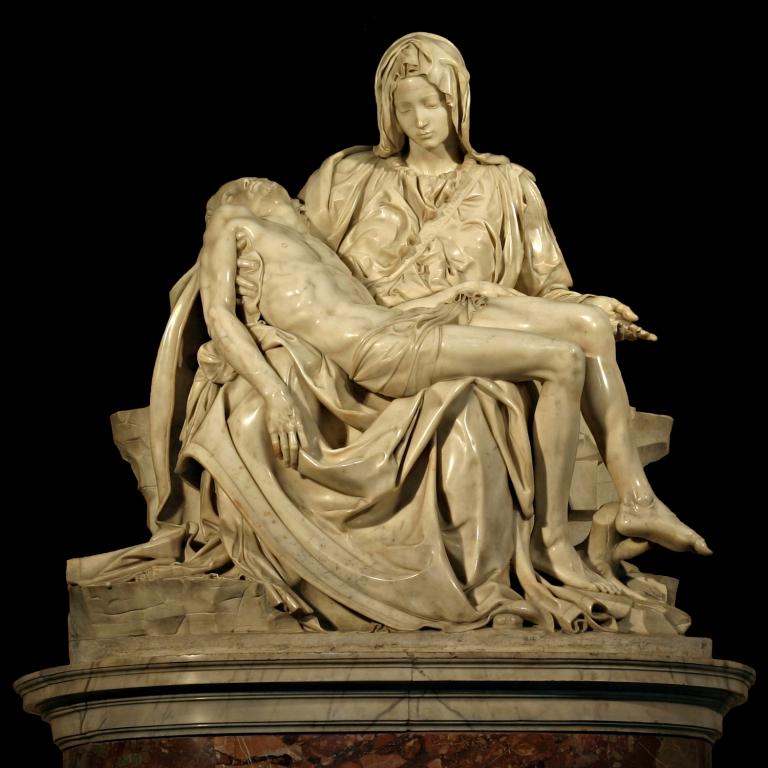Art, Racism, and the Problem of White Jesus
I want to say a few more words about all the destruction and removal of municipal statues that we’re seeing in the news lately– especially since talk has now turned to religious art.
First of all, art is important. Art is very, very important. Art is language. The fine arts are how we humans communicate, understand, heal, accuse, confess. Art is informed by culture but it also informs and moves cultures. It’s hard to place too much importance on the arts.
Here’s the thing, though. Art is not more important than people.
Usually you don’t have to choose between art and people, but just in case.
Also, most municipal bronze and plaster displays aren’t really fine art. Some are. Most are about as artistically valuable, creative and beautiful as billboards, and they serve roughly the same purpose: propaganda. Advertising. It’s a kind of commercial. A giant photo of a fast food hamburger is supposed to make you buy one, and a bronze cast of Jefferson Davis is supposed to make you think that Jefferson Davis is someone worthy of being a subject of bronze casts. They are messing with your mind. A certain amount of mind-messing is part of life, and grown-ups learn to get their information from reliable sources instead of commercials. But we all, at one point or another, form our thinking based on commercials. We all end up buying that hamburger or something equally unhealthy, at one point or another. Commercials are powerful things.

Some religious art is also a commercial. Far from all of it is. Icons are not just art but religious objects and sacred. Lots of Western religious art that is used like an icon, statues and paintings and church architecture– these are sacred too. Even the cheap plaster statues that decorate parochial churches are sacred, not because of their artistic value, which is often awful, but because of the purpose they’re used for. But some art that depicts a subject in Christian painting is a commercial. Think of a Pure Flix film. Think of the illustrations in a tract, or even a catechism. Think of a painting of Jesus that some preacher waves at people he wants to shame and humiliate.
Commercials themselves are morally neutral. If they advertise a bad thing that hurts people, they are evil, and if they advertise a good or neutral thing they’re okay. They’re nowhere near as important as art, and far and away less important than people, even if they advertise for something good.
If a society decides to do away with some commercials they deem hurtful and dangerous, they can do that and they probably should. That’s not “erasing history” or “mind control” or “being politically correct,” any more than it’s mind control to order television stations not to air a commercial that makes you want to eat a poisoned hamburger. It’s part of keeping the public safe, even if it doesn’t look like it to you. And a church can do it as well– they can take a feast day off the calendar or discourage a private devotion.
Now, with all of that said: it is normal and actually good, that people throughout the centuries have made devotional art of Jesus and Mary, that depicts Jesus and Mary looking like the artist does, or like they belong in the artist’s culture. Jesus came to make His dwelling among us. He did this historically two thousand years ago in ancient Palestine, but He also does this in everyone’s life, through the miracle of the Incarnation. He takes everyone’s experiences, our stories, our joys and sufferings, to Heaven with Him and makes them a Godly thing. That’s Christianity. And it’s wonderful. Christ is incarnate in Ireland, and in the Arctic Circle, and in China, and in Sudan, and in the Amazon rainforest, because people are there. Our human experience is our path to Heaven and part of the Life of Christ.
So it’s great that people from Northern Europe decorate their churches with white Jesus and Mary, and people who came from those cultures brought those images to America as immigrants. It’s fine that my Irish granny has an Our Lady of Grace statue in her kitchen, and Our Lady’s skin is so pale it looks like she came from Waterford on the same boat my ancestors rode. It’s fantastic that Japanese Catholics depict Jesus and Mary looking Japanese and wearing traditional Japanese clothes. It’s beautiful to see a Native American icon of the Holy Trinity, and it’s super that Amazonian people portray the Virgin Mary with their own skin and hair coloring, in clothing that’s normal for them but that Europeans and North Americans would consider immodest.
People who make those images are telling a wonderful truth about our Faith, whether they know that’s what they’re doing or not. They’re making art about the Incarnation.
But here’s the thing.
People are also guilty of using that art as a commercial, and sometimes those commercials are for atrocities.
This happens all the time as well. A conquering race comes to a country and sets up shop, not to share the joy of Christianity with the people they meet there but to hurt and use them for profit and use Christ as an excuse. This is blasphemy of the worst kind. And they can use their iconography of the Jesus and Mary that look like them, as a commercial.
White Europeans have gone into other people’s countries, and forced devotion to the blonde-haired, blue-eyed white Jesus as if He is the REAL Jesus, their culture is the REAL culture, and any other color and culture of person is degenerate. They have used this notion of Jesus as an excuse to try and wipe out other people’s cultures, to view European culture as the One True Christian Culture and to erase other people’s cultures.
This is blasphemy and gravely sinful. Cultures are made up of people, who are created in the image and likeness of God and who are also sinners. No culture perfectly embodies the teachings of Christ, and no culture is purely sinful either. Christianity can be lived in anybody’s culture with about equal difficulty– a Bedouin as much as a Massai as much as an Italian housewife, they’re all going to have to turn from sin and pursue virtue. They don’t have to become European to do it. We are all created in the image and likeness of God, and we are all sinners. Our cultures are all bound up in the sin and weakness of fallen humanity but they are also all important, valuable and holy because they’re where God comes to dwell with us.
I have seen two very serious errors this week, which stem from a misunderstanding of why Christians make art. The first, which I only saw one influential person demanding, was that we ought to destroy all images of a white Jesus and Mary, because they’re necessarily imperialist and racist. And this isn’t true. They’re a natural thing for a person who is white to make as part of their religious practice. And as such, they’re harmless and beneficial. When they’re used as commercials to assist in the genocide of someone else’s culture, that’s a blasphemy that inflicts a severe trauma, so I’m sure I can understand why people who aren’t white should resent white images of Christ and Mary. I empathize with people who never want to see a white Jesus and Mary again. I would love to see churches and homes all over the world crammed with images portraying Jesus and Mary in all different cultures and races. But the white images themselves come from something good.
The other error, is white people claiming that images of Jesus and Mary from other cultures are somehow wrong, silly, ignorant, anti-Christian, “rewriting history” or “politically correct.” Those images are sacred and important. It doesn’t matter that “Jesus wasn’t African,” as I saw somebody complaining. First of all because Jesus’s coloring when He became incarnate in ancient Palestine was probably much closer to an African person’s than to a white person’s. But also, because Jesus became incarnate for and with all the people in all the different cultures and races of Africa, just as He did for and with other races of people. And He identifies with victims of violence and persecution most of all, making a dark-skinned Jesus with deliberately strong African features a very important icon for our times.
Art rises out of people’s cultures and experience, and so does religious art. This is very good. Art used as a commercial is silly, and a commercial for genocide is blasphemy. Assuming that other people’s art is a commercial and therefore bad, is terrible as well.
Christ is incarnate among us. That’s something we should all be allowed to have.
Question Friday: What’s Your Favorite Christian Painting or Sculpture?
What is your favorite Christian painting or sculpture?
This is a really really hard question to answer. There are a lot of factors that go into my appreciation of any piece of art that it’s hard to say that I have a definitive “best” piece that I love. What I will do is give you a few things that I look for in art, and an example of a work that I think exemplify that element well. I would also like to hear from all of you. if you have a favorite work of art please let me know in the comments below!

1) Theological Content – many have made the observation that religious art can not only be seen but read. Religious images have their own language in symbol which articulates a message. I love religious images that have depth in their use of symbol and say something important in their portrayal of the faith. You can read more about how these pictures can be deciphered in The Art of Faith: A Guide to Understanding Christian Images by Judith Couchman. One example of this that I love is the icon of Jesus’ baptism. I can look at almost any version of this icon for hours just thinking about the interplay of symbols.
2) Beauty – It probably goes without saying that beauty is an important aspect of art. In beauty I think we can capture a glimpse of the life of God. I am always amazed at the ability of some artists to capture a moment of beauty in canvas or marble in ways that I could never have imagined. This is one of my favorite parts of walking through an art museum. Sometimes you stumble upon a picture that catches your eye and your heart and seems to breathe a glimpse of heaven into the room. It’s one of the most compelling arguments I have found that we are creatures created in the image of God. God is the author of beauty and somehow has invited us to become collaborators. One image of beauty that I love is Henry Ossawa Tanner’s depiction of The Annunciation. I can’t explain it, but I find it captivating.
4) Challenge – One thing I really like in a work of art is to find myself challenged by it. I believe art can convert us in a way that nothing else can. Artists often function as prophets, and art sometimes serves as our conscience. I highly value a piece of art which confronts me. I need images that push me to love more deeply and generously and to serve more whole heatedly. There are a number of works of art that can do that, but most recently I have found inspiration in the Homeless Jesus Sculpture by Timothy P. Schmalz, which helps open my eyes to the presence of Christ veiled in the distressing disguise of the poor all around me.
5) Emotion – Art has an amazing ability to stir up emotions within me. One of the things I treasure is an image that conveys emotion. The amazing thing about Jesus is that God chose to reveal who he was in the language of flesh and blood that we all live and understand. Because of this I am particularly susceptible to portrayals of Christ that demonstrate how incarnation he truly is. One powerful example of this is the image of Our Lady of Perpetual Help. In it Christ is depicted as having just jumped into his mother’s arms after a vision of the instruments of his crucifixion has frightened him. One sandal hangs dangling from his foot as representation of the startled leap which resulted in the sacred embrace depicted. Powerful stuff!
6) Craftsmanship – There is something that has to be said about craftsmanship. There is often a sense of awe I experience when standing before a painting or sculpture. I am humbled by the skill through which the artist was able to bend raw materials into forms of elegance and beauty . I am filled with wonder at the imagination that was able to form the impetus of what I see before me, and the skill which was able to bring the imagination to life. One of the works that I am continually in awe of it the Pietà by Michelangelo. The life that given to the hard stone is a thing of wonder. It’s truly a remarkable achievement.
I don’t think there are too many works of art that do all of the things I mentioned, but they are all things that are valuable to me. So I guess I don’t have a single work of art that’s my favorite. I hope that giving you a few examples of things that I love helps. What religious art do you love.. and why?
Jesus, the Artist: Man Can Corrupt Religion, Not Art.
We all love stories. I haven’t met a human that doesn’t. Whether our stories entertain us through movies, books, TV shows, fine art, or lyrics, it is one thread of life that we all spin. Humanity has evolved through messages brought through this simple yet divine act of storytelling. The meaning derived depends on the listener, yet, an artistic story is near impossible to corrupt because art isn’t so obvious on the surface. It is often a forgotten trait of Jesus; that he was a writer, a storyteller, an artist.
If Jesus were here today, in the modern world of written word and the internet, I have no doubt that he would be a writer. Perhaps he would blog his parables, or make memes of his unique teaching quotes on Instagram, using the hashtag #writersofinstagram. He was an artist, and all artists desire to share the truth that lives inside of them.
Storytelling is the Divine’s genius way of bringing forth progressive ideas of the human consciousness. Where would we be without fairytales?
We learned not to lie through ‘Pinocchio’.
We learned never to judge a person by the way they look through ‘Beauty and the Beast.’
We learned not to talk to strangers through ‘Little Red Riding Hood.’
Storytelling is an example of the Spirit still speaking. God isn’t done speaking, nor is God done creating a better world. We can change the world through art, just as Jesus brilliantly knew, which is why he spoke his truth through parables.
Man cannot corrupt a story. They can try, however, it is pretty difficult unless the corrupt are keenly aware of how to change a story to such a degree as to destroy the deeper meaning. The mystics, other artists, and other right brain humans can interpret the deeper truth. Artists see art and it’s second nature to get inside the story and dig up the core. This is why most artists do not fare well in boxes made up by society. There is not a cage big enough to contain us. We cannot exist in closets nor can we live our days in silence.
This is, I believe, what has caused the divide between the religious and non-religious/progressive religious. It is a shame, really, because the core of Christianity was born with a freethinking, secular humanist within his Jewish community. He spoke of radical ideas for the human that did not fit neatly into the Jewish religion. He blew their minds with words they had never heard before. Teachings of love, grace, forgiveness, healing the sick, caring for the poor, welcoming the neighbor/foreigner, and most revolutionary-non-violence.
In my observation, the church at large wouldn’t like Jesus today. They’d probably demonize him with insults like “bleeding heart liberal”, or “godless heathen”, just like Franklin Graham did recently on Twitter:
“Christians should be aware of candidates who call themselves progressive. Progressive is generally just a code word for someone who leans toward socialism, who does not believe in God, & who will likely vote against Godly principles that are so important to our nation.”
As a person that was raised to worship and love Jesus, and stick up for Jesus, I am lost on this assessment of Progressives. Religion has taken over the message of Jesus, and all it is doing is causing division and harm. I cannot choose religion because more often than not, religion does not choose humanity. If it isn’t what is best for the human, it isn’t what is best for me, because first and foremost I am a human, as was Jesus.
However, with all of this corruption and defacing the figure of Jesus, there is hope. Art cannot be corrupted. The parables speak for themselves, the message lives on, and love is the answer. We can stay in peace, and believe that we can move mountains blocking humanity and the world from thriving.

And remember, Matthew, Mark, Luke, and John were also artists.
Maybe you are too. Maybe we all are, perhaps we all possess the ability to shape a better world, but first, we have to get out of the boxes that were built around us.
Readmore: Jesus Christ Artist
The Pietà and the Love of Christ
Michelangelo’s depiction of Mary holding the body of her dead Son, “The Pietà,” is one of the world’s greatest works of art. I just read an essay by a woman who told how it was instrumental in her conversion to Christianity. So I thought it would be appropriate to contemplate for Good Friday.
One can appreciate the sculpture for its stunning artistry–how its 24-year-old artist makes stone drape like cloth; the dynamic triangular composition; the synthesis of classical form and Renaissance naturalism. Critics have observed that the figures are out of proportion–Mary is too big and Jesus is too small–and that Mary appears younger than she would have been–but such complaints only disclose more levels of the artist’s genius. Michelangelo was not trying to anticipate photography but to make an artistic point: The effect is to remind us of the young Mary cradling the young Jesus when He was a child, but now she is holding His dead body after He has been crucified. Christmas and Good Friday come together.
That poignancy is only part of this work’s emotional impact. Jesus’ body, while tastefully not shown realistically as tortured, is so limp, His head lolling back, and so physical, his muscles and veins rendered with anatomical precision, underscoring that this is definitely a dead body. And Mary’s face is ineffably sorrowful, yet also serene and sublime. And what is that gesture with her left hand? She seems to be offering Him to us.

Michelangelo titled his sculpture not “Mary and Her Dead Son” but, following the artistic genre, “The Pietà,” that is, “the pity,” though the Italian does not have the weak connotations the English does. Think “The Compassion,” or, “The Mercy.”
So are we supposed to feel pity for Jesus and for His mother? That’s certainly the effect of the sculpture, but that isn’t the full meaning. Mary isn’t shown in anguished mourning, with Jesus as a tortured victim, as in other works on the same subject. “The Pity,” compassion, mercy are for us. “God so loved the world, that he gave his only begotten Son, that whoever believes in him should not perish but have eternal life.”
You don’t have to be Catholic or venerate Mary to appreciate this masterpiece of Christian art, which is housed in St. Peter’s Basilica at the Vatican. I was struck by the impact this work had on two women who saw it.
First, the Jewish woman who converted to Christianity. She tells about seeing the statue at the New York World’s Fair, where it was on loan from the Vatican in 1964-1965, when she was 9 years old. From Myra Kahn Adams:
Finally, we entered the pavilion stepped onto a moving walkway, and I remember being awestruck by the most beautiful statue I had ever seen. It now sounds implausible to write that I did not know the name of the dead man lying on the woman’s lap or the story depicted in the sculpture. Ignorance aside, the Pietà spoke to me. There was no “voice,” but I felt an imprint on the fabric of my soul with a riveting, “you will never forget this” moment. (And of course, I never have.) Looking back, it was as if a seed had been planted. Eleven years later at age 20, the “seed” blossomed, and I converted from a non-practicing Jew to a practicing Christian.
So what am I saying, and why am I telling you this?
Let’s start slowly. Regardless of one’s religious beliefs, it is nearly impossible to look at the Pietà and not experience overwhelming grief and sorrow for a mother who just lost her son. Michelangelo’s masterpiece packs such an emotional punch that you can almost see tears streaming down the marble. So powerful is the sculpture that you never forget seeing or feeling it. . . .
The power of the Pietà is that it radiates the greatest power in the universe — the love of Christ.
She didn’t really become a Christian from seeing a visual image. “Faith comes from hearing, and hearing through the word of Christ” (Romans 10:17). As she says, she didn’t even know who that dead man on the woman’s lap was. She had to hear about Christ by means of language, which came later. But remembering the sculpture, though years later, helped her to realize and appreciate the love of Christ. (The author is kind of confused, saying that despite Christ’s death, He did not die–meaning, I suppose that He didn’t stay dead–and that even those who do not believe have His spirit, showing the continuing importance of The Word.)
Here is another reaction to the Pietà, this time a young mother, who describes being in St. Peters with her three-month-old son, taking him out of his stroller amidst the crush of the tourists, then seeing the statue. From Annemarie Keiderling:
I had seen photographs of Michelangelo’s Pieta, but had forgotten that it would be here. Its power was overwhelming and drew me like a magnet. I walked up close. Here was a mother just like me, and in her face I could see the same passion of love, a love beyond explaining and like no other, that I felt for my own child. But in her face was also a suffering I had never known. I remembered the “sword that cut through her heart” and I held my son closer, wondering how she survived it. . . .
But there is something else in Mary’s face. I see her love and her pain, but I also see deep reverence. The body cradled in her lap is her child, but also her God. She knows she is holding a soul of greatness as far beyond the wretchedness that killed him, as the sky towers over a clod of earth.
In her face is the promise of Easter and of resurrection.
Readmore: Jesus Christ Artist